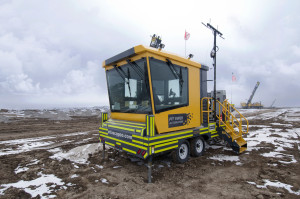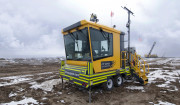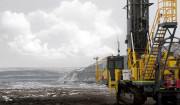Since Atlas Copco first introduced its electronic Rig Control System (RCS) in 1998, innovative features based on RCS have come steadily, one after another. Automating the control of various rig functions replaces human experience and multiple inputs from joysticks and switches with computerized inputs based on sensors and software.
The most noticeable gain from automation is that the control system will not deviate from how it was trained to perform. While even the most masterful driller varies slightly in performance from one repetition to the next due to fatigue, distraction or simple error, RCS performs each repetition with reliable precision. A master driller might beat its time in a single repetition, but for most tasks, the automated system will outpace the driller by the end of a shift. It also means automated operating performance can be replicated shift after shift, no matter which human operator is monitoring the automation.
Fifteen years and four RCS generations later, automation packages are available for any Atlas Copco Pit Viper drill. Atlas Copco?s suite of office-based software tools, such as Surface Manager, complements automation packages with easy-to-use reporting interfaces. Surface Manager displays Pit Viper data in a sensible layout to map drill usage, evaluate production statistics, track consumables and compare planned outcomes against actual results. Portrayed on charts and graphs, such active management tools help with driller training and provide decision-making support for all stakeholders.
Increased automation equals increased utilization
Paulyn Espíndola, Product Manager for Atlas?Copco Drilling Solutions in Chile, says one of his copper mining customers is increasing rig utilization by expanding where it can use its drills. The Atlas Copco Pit Viper 351 diesel rig that joined a fleet of five PV-351 rigs in April, is the first teleremote rig for open pit mining operations in Chile. Complete wireless control of the rig allows the operator to now drill anywhere he?d like on the bench since the driller is well away from the drilling operation. Espíndola says the copper mine had a unique challenge that only automation could overcome, and the Pit Viper automation package allowed the mine to choose features and upgrade packages that precisely matched its operational needs.
Automation for limited resources
Dustin Penn, Business Line Manager for Atlas Copco Drilling Solutions in Australia, serves several iron ore mines with the RCS-based PV-271 blasthole rigs. Some have pushed forward from AutoLevel and AutoDrill to more advanced systems to continue to conquer operational and strategic goals. ?The issue in Australia,? says Penn, ?is the limited workforce and the extraordinary expense of personnel logistics for our customers ? everything from employee housing and food service to transportation. It?s a two-hour flight for them to get in and out of the mine.?
 The goal for these Australian mines is to expand their capabilities by growing a fleet with the drillers they have, and that means automation. Penn says: ?With automation, the driller can become a supervisor of a drill fleet, not just a single driller operating one machine. Automation will not just lower production costs but will also streamline servicing. Multiple services such as water, fuel and visual inspection will be performed at once, more efficiently. Combined with the decreased downtime at shift changes, automation promotes greater Pit Viper utilization.
The goal for these Australian mines is to expand their capabilities by growing a fleet with the drillers they have, and that means automation. Penn says: ?With automation, the driller can become a supervisor of a drill fleet, not just a single driller operating one machine. Automation will not just lower production costs but will also streamline servicing. Multiple services such as water, fuel and visual inspection will be performed at once, more efficiently. Combined with the decreased downtime at shift changes, automation promotes greater Pit Viper utilization.
Penn emphasizes that transitioning to automation requires unified dedication from all management groups at a mine, from senior management to IT and human resources departments, to drilling, planning and blasting. Then the mine has to integrate with the supplier. Penn?s customers set up cross-functional teams to work with
Atlas Copco as they incorporate automation into the mine?s operations.
The rewards make the integration process worth it, he says, resulting in predictable productivity that will help the mine accurately calculate capital from its drilling and blasting plans. Penn adds that automation also brings a greater level of equipment reliability, making fewer mistakes than human operators, and that everyone is happy from management to investors.
Commonality and dynamic integration
Tyler Berens, Atlas Copco?s Product Line Manager for automation products on surface drills, says: ?Automation isn?t about having a good day or a bad day. It?s about having a predictable and repeatable day.? He says that kind of consistency arises from two points about Pit Viper automation. First, the automated features are based on the RCS system which is familiar to all drillers who have operated Atlas Copco RCS-equipped rigs. Therefore, commonality of the operating system, similar ergonomics and drill functions reduce training time as drillers adjust to auto-modes. Secondly, if a mine wants to add drills to its mine plan, multiple Pit Viper rigs can be operated by the same operator or by multiple operators, in the safety and comfort of the teleremote control center. Dynamic integration is part of Atlas Copco?s Automation DNA.
?Upkeep of the automation was meant to be simple, as well,? adds Jon Torpy, Atlas Copco Drilling Solutions VP of Marketing for Blasthole Drills. ?We train existing technicians on Pit Viper maintenance, and we stand behind it. As you can see, we have the capacity to support this product around the world. The result is predictable, reliable and efficient productivity, shift after shift.?
And with Pit Viper drills, monitoring and supervising is a remote feature that can be done as easily in the cab as back in the office, at the mine or anywhere in the world. Berens gives an example of putting technology to work at a coal mine running two PV-275 rigs. One PV-275 uses RCS electronic control while the mine?s newest PV-275 has received automation upgrades that include auto rod changing and teleremote operation.
Auto Rod Change, smooth and consistent
Bryan Scoggin, one of Atlas Copco?s drillmasters, commissioned the PV-275. Scoggin, who has years of experience of rotary drilling in just about every type of material, says when he commissioned the first Auto Rod Change system for this operation, he was ?blown away? by its performance. ?I have plenty of experience with changing pipe in multi-pass operations, and while I may beat the system over a couple of holes, it usually beats me over the course of a few hours of drilling. The Auto Rod Change is one of the smoothest most consistent automations that I have had the opportunity to work with.? Berens adds that the mine concerned prides itself on its world-class productivity and looks to use automation to eliminate variances from shift to shift and driller to driller. As the auto rod changing feature demonstrates, automation helps newer drillers reach the productivity of experienced drillers faster. Atlas Copco has seen consistent performance from the PV-275 with automated systems in line with some of the mine?s better operators. Berens explains: ?While it can?t out-drill the best operators yet, it is able to keep up with and out-drill many of them consistently, shift after shift, day after day ? and that?s the real payback you get from the RCS technology.?
He continues: ?The operators at this mine told us in the beginning that they had their doubts, but they regularly comment now on how impressed they are with how well the technology works. In the end, that?s what?s important, that we have a reliable, mine-ready product that has a real impact on the overall performance of the mining operation.?
This same coal mine has recently put teleremote operation to use. Scoggin pointed out how easy it was for the operators to make the transition from drilling on board their drill to running it teleremotely. ?They already had one RCS-equipped PV-275. The two run the same, so the drillers knew what to expect,? he says. ?Several operators told Bryan that they couldn?t believe how simple it was and that in the future they couldn?t imagine who would want to go back on a rig after sitting in the comfort of the teleremote station.?
A matter of comfort and safety
Chris Graves, Sales Support Manager for Atlas Copco Drilling Solutions in Canada, says the first mine to use teleremote in his country had approached Atlas Copco for a solution to overcome two major safety concerns. One, the region is plagued seasonally by severe electrical storms. Lightning detectors placed well beyond the mine?s periphery give it sufficient lead time to safely recall drillers from their rigs who sit exposed to the storm on open pit benches. The drillers take shelter in a building to wait out the storm. During such storms, which can be daily occurrences, the mine had been losing two to three hours of drilling. Two, the mine also wanted to extend its surface pit over a historical network of underground workings. Remote operation removes any concern for the driller?s wellbeing over a previously worked property.
Atlas Copco upgraded the Canadian mine?s PV-235 with a teleremote kit. That first drill was operated from a protected operator station installed on the bed of a pickup truck. It was so successful that the mine ordered another conversion, this time mounting a PV-235 cab on a trailer, which can be relocated by a wheeled truck or tracked vehicle. The cab is compact enough to move easily about the mine yet gives the operator the same room and comfort of the rig itself, without any of the noise or dust.
The remote control station does not need to be within sight of the rig, since every gauge and display on the rig is cloned within the station. In principle, the only limitation for how far the remote control facility can be from the rig is the capability of the network used for remote communication. The customer has the choice of running teleremote on the customer?s own wireless network or on a separate radio network set up by Atlas Copco.
Berens says user-friendliness was a design feature of the automation products. ?Atlas Copco automation is meant to be easy, intuitive and simple.? This ease of use supports operation of multiple rigs from a single operator?s station.
Graves points out that the Canadian mine has been successfully controlling two PV-235 drill rigs simultaneously. ?From a single remote operating station, the driller moves one drill over its hole and starts the auto-drilling process, and then moves the second drill over its hole and begins its auto drilling process.? He adds that the mine may choose to have a single driller controlling more machines, but sees sufficient benefit in just being able to cover for a driller who is sick or has taken time off, or being able to add drills without waiting to add new drillers.
As robust as the operating platforms
Jon Torpy, Atlas Copco?s VP Marketing for blasthole drills, describes the development and release of Atlas Copco technology systems. ?As a former mining engineer who has worked in open pit mining, I feel very strongly that we need to release mining-ready technology. The technology on the Pit Viper has to be as tough as the Pit Viper drill itself, and we have now demonstrated that we can do that with technology running in multiple types of mining environments around the world.
Developing the technology to be efficient is just one piece of making it successful. Designing it to be robust and to fit within the existing maintenance infrastructure of our customers is the other piece.?
Berens emphasizes that Atlas Copco subjected all technology to the most extreme conditions it could find. This was to ensure that the automation products would be at least as robust as the operating platforms of the Pit Viper family. Pit Viper drills have been subjected to years of use in the dust and extreme heat of the USA?s desert copper mines in Arizona, as well as in the extreme subarctic cold of interior Canada and Northern Europe. Teleremote operation of a PV-235 in the Canada mine, for instance, was unaffected during this past winter even in temperatures that fell below ?40°C (40°F). The Chilean copper and molybdenum mine?s PV-351 rigs have no trouble operating at an elevation of over 3?500 m (11?400 ft).
Both Torpy and Berens say that 2014 is going to be an exciting year with ?much more to come in the way of technology?. Multi-rig remote control is the first in a series of high-tech advancements that are planned for launch in 2014, with fully autonomous drilling now a realizable target in the not-too-distant future.
Epiroc operated under the trademark “Atlas Copco” prior to January 1, 2018.




Here:
Us: